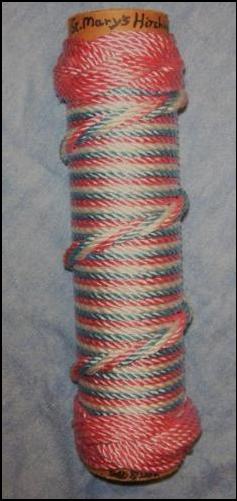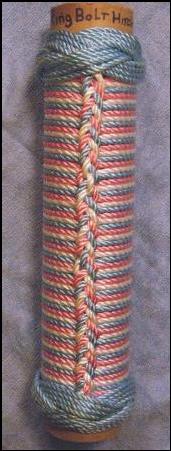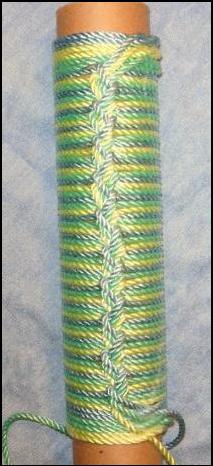|
More Than Knots |
|
Hitching |



|
Hitching:
Hitching has been called by several names; Coxcombing, Cackling and Hitching. In essence it is covering an object (usually a railing) with cordage tied with half hitches. The number of strands per style can vary from two to six. Different patterns are formed by varying how the half-hitches are tied giving different pleasing effects. There are at least 30 different patterns that can be formed with hitching. Some examples follow: |

|
Ring Bolt hitching (3 stranded):
The pattern formed in Ring Bolt hitching (shown at the right) is created using three cords hitched in a left, right, left pattern. Ring Bolt Hitching gets its name because this style of hitching was used to cover rings attached to deck plates. The hitching decreased the amount of wear on the rings and reduced the clanking noise the rings made when banging against the plates. Quite often, Ring Bolt Hitching is called Coxcombing.
Another use of three stranded Ring Bolt hitching is to cover hand rails. If you visit the Star of India you will see most of her railings covered with Ring Bolt hitching made with marline cord. The Ring Bolt hitching gives a nice grip on what could otherwise be a wet, slippery railing.
I use Ring Bolt hitching on my walking staffs. After finishing the hitching, I preserve the cordage so it will form a nice handle for my staff. |

|
St. Mary's hitching (3 stranded):
Another fun hitching pattern to make made with three cords is St. Mary's hitching. The pattern formed is created by hitching the cords in the same direction. The first cord is hitched to the right or left. The next cord it hitched over the first in the same direction. The last cord is hitched over the first two and in the same direction. From then on, the cord farthest back is hitched over the previous two and in the same direction. St. Mary's hitching forms a pattern that has a base of cords with what appears to be one cord wrapped around the others in a spiral pattern.
While St. Mary's hitching is perhaps the easiest to make, care must be taken on how it's used. The first thought is that St. Mary's hitching will make a great handle. However, what you will find is only one nail can be driven with a hammer handle that has been covered by St. Mary's hitching. The raised cord cuts into your hand and makes it too sore to do any more than a small amount of work.
That said, I've seen St. Mary's hitching used on plier handles. Used in deep sea fishing, the raised cord will cut through fish slime on your hand and give you that necessary grip to remove a fish hook. This is especially important when handling an angry Barracuda with razor sharp teeth. |

|
Zig - Zag hitching (3 stranded):
Yet another fun hitching pattern to make made with three cords is Zig-Zag hitching. The pattern formed is created by first hitching all three cords in the same direction - either right or left. Then reverse the direction for the next three hitches. Continue hitching three right, three left, in an alternating pattern until the area is covered. Zig-Zag hitching forms a pattern that has a pleasing left, right, left style.
When hitching, the first cord is hitched to the right or left. The next cord it hitched over the first in the same direction. The third cord is hitched over the first two and in the same direction. Reverse direction and repeat the above pattern.
When using three stranded cordage, care must be taken when hitching against the lay of the cordage. I find that giving a twist to the cordage to make the lay tighter before making the half-hitch keeps the cordage much neater. |